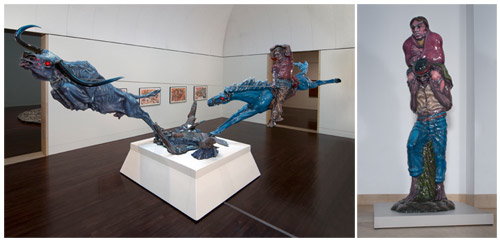The Blanton Museum has announced the acquisition of two large fiberglass sculptures by UT alumnus, Luis Jiménez, Progress II (1976/1999) and Cruzando El Rio Bravo [Border Crossing] (1989).
“Over the past several months, Progress II has become one of the most visited works in the Blanton collection. Border Crossing is sure to draw similar attention. The works’ scale and dramatic sculptural forms make them uniquely compelling for visitors of all ages and backgrounds,” comments Annette DiMeo Carlozzi, the Blanton’s curator at large. Progress II underwent comprehensive restoration and was placed on view at the museum in the second floor collection galleries earlier this fall. Now Border Crossing, a gift from Jeanne and Michael Klein, has just been installed on the museum’s mezzanine.
Luis Jiménez (1940-2006) grew up in El Paso, Texas. At the age of six, he began working at his father’s neon sign shop, where he was exposed to welding and spray-painting techniques. As a young adult, Jiménez moved to Austin to begin his formal study of art at The University of Texas, where he received a Bachelor’s degree in Fine Arts, ’64. Never straying far from his roots, Jiménez continued to work with industrial materials, seeking to create “a publicly accessible American art.” With colorful illustrations of working-class heroes and larger-than-life sculptures that borrow freely from popular culture, Jiménez championed the everyman throughout his career.
Progress II, a massive sculpture cast in fiberglass and finished with car paint, belongs to the artist’s 1976 series that critically examines mythologies of the West. Rectifying traditional cowboy imagery, the work features a Mexican vaquero – the original cowboy – closing in on his prey: a snarling, red-eyed longhorn hopelessly attempting to evade defeat. Beneath the larger components of the sculpture, an owl stalks a mouse, while other small living creatures fight for their survival. An overarching theme of pursuit is revealed as Jiménez uses relationships between predator and prey to allude to the concept of Manifest Destiny, America’s road to “progress.”
Border Crossing, 1989, also made of polychrome fiberglass, illustrates an act of emigration. Totem-like, the sculpture depicts a man carrying a woman clutching an infant on his back as he crosses the Rio Grande River in search of a better life. Border Crossing is dedicated to Jiménez’s grandfather, who crossed the Mexico/U.S. border with Jiménez’s grandmother almost a century ago.


